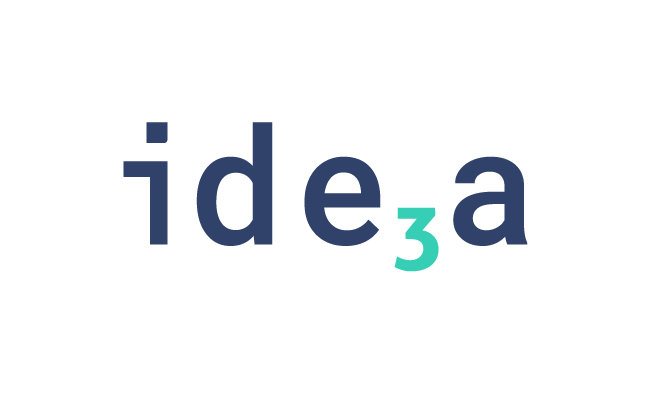e-research
Within ide3a a team of international experts works to deepen the knowledge on the digitalisation of critical infrastructure and on how digital teaching formats can succesfully be used to convey this knowledge.
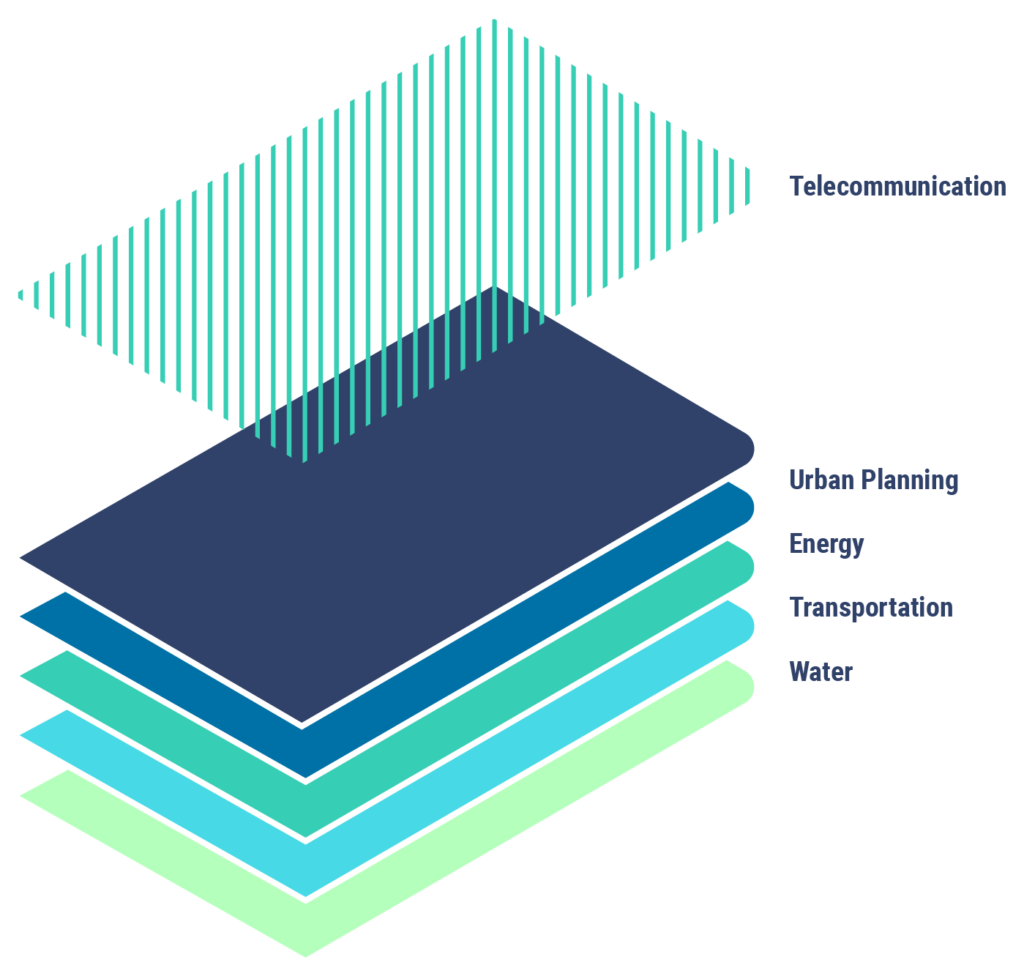
The topic „Critical Infrastrucure & Digitalisation“
The ide3a consortium’s mission is developing learning and research content on the topic of critical urban infrastructure and digitalisation. Urban critical infrastructure systems of interest include water networks, energy grids, sensors / telecommunication networks, transportation systems, and green infrastructure. New digital technologies for advanced modelling and management of these systems, with primary focus on their inter-connections and dependencies constitute the research core in ide3a. Ultimately, ide3a explores the opportunities and challenges brought by the digitalisation of urban critical infrastructure systems, e.g., through the use of digital sensors, IoT, and advanced analytics tools, to foster sustainability, resilience, and inform decision making in these multi-stakeholders systems.
Serious Game ConnectiCity
The open-source serious game ConnectiCity is developed by the ide3a project partners at the Technische Universität Berlin as a tool for education about climate-resilient cities and inter-connected critical urban infrastructure systems. ConnectiCity provides an interactive multi-layered digital environment to enable scenario analysis, system simulation, and planning of urban critical infrastructure systems under heterogeneous social, technical, and climate scenarios. Its purpose is to provide its player base with an interactive experience that introduces them the topics of climate-resilient cities and interconnected critical urban infrastructure systems. As part of interconnected critical infrastructure systems in an urban environment, stormwater and mobility networks are in the focus of ConnectiCity.
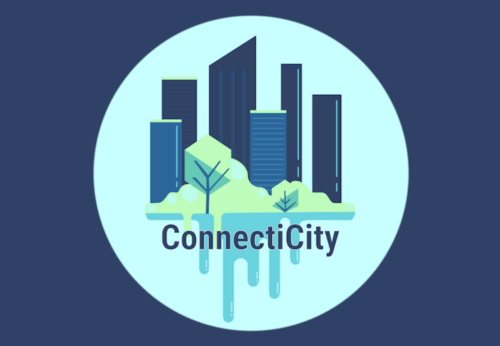

The serious game ConnectiCity is developed by the ide3a project partners at the Technische Universitaet Berlin, used for education and published as an opensource game. The game will be a multi-layered digital, open source, serious game to enable scenario analysis, simulation, and optimisation of urban critical infrastructure systems under heterogeneous social, technical, and climate scenarios. As part of the urban environment this includes interconnections with other critical infrastructures (e.g., electric grid, telecommunication networks, mobility, ecology and other urban networks). Its purpose is to provide its playerbase with an interactive experience that introduces them to important topics such as climate-resilient cities and interconnected critical urban infrastructures.
In addition to the game itself, ConnectiCity offers a glossary containing information on key terms and concepts covered in the game. This glossary can be accessed during gameplay to enhance understanding and explore additional information related to the game’s topics.
In ConnectiCity, players assume the role of an expert consultant who is introduced to the mayor of the City named Connie. Connie explains that her city is facing extreme weather events that have been causing damage in multiple neighborhoods, while also dealing with the challenges of a growing population. To address these issues, ConnectiCity is developing a new neighborhood designed to serve as an exemplary area capable of facing various challenges.
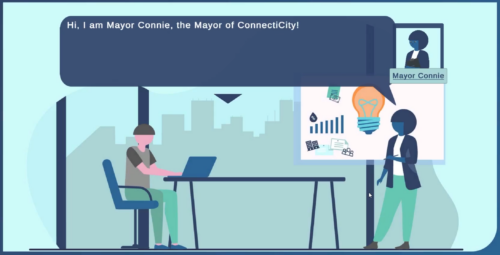
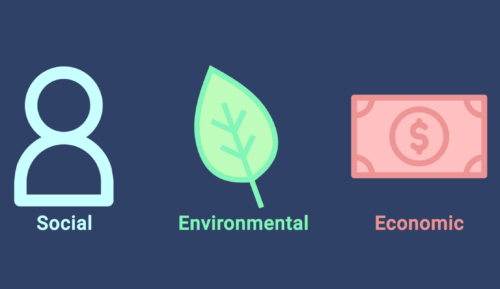
As the expert consultant, the player’s task is to develop a plan that simulates different scenarios and creates a sustainable and resilient new neighborhood over ten rounds, representing ten years of city development. The goal is to achieve a high score in three categories: social, environmental, and economic. This is accomplished by managing a variety of trackers that represent different aspects of city development.
The player must find the right balance between each of the aforementioned aspects while considering the increasing needs of the growing population, such as housing and job opportunities. ConnectiCity’s map is divided into two groups of subcatchments, designated for housing or businesses. The number of housing units corresponds to the population capacity, while the amount of businesses reflects the environmental aspect of unemployment.
Constructing buildings increases the terrain’s imperviousness, thereby raising the risk of flash floods. Moreover, constructing more structures increases traffic flow on the map, resulting in higher carbon emissions. Poor management of BGIs will result in penalties for the player. In addition, traffic intensity is indicated by a color scheme, with high traffic intensity associated with high carbon emissions. Players can mitigate these emissions by incorporating public transportation in ConnectiCity.
As a simulation-based game, the different hydroclimatic scenarios implemented in ConnectiCity are pre-simulated using the SWMM model [1] on the Bellinge open dataset [2], which inspired the drainage network topology in ConnectiCity.
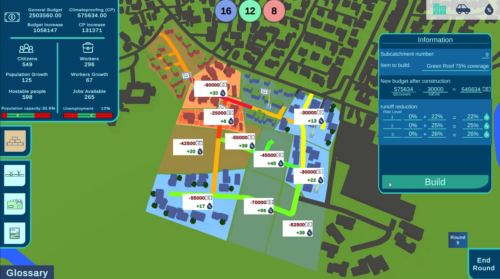
To know more about Connecticity or get access to its release and open-source code, check out the promotional video below and the following resources:
· ConnectiCity release and GitHub repository
· ConnectiCity documentation
Check it out and help Connie making ConnectiCity more climate-resilient. Will you be· able to avoid any flash floods in ConnectiCity?
References
[1] Rossman, L. A. (2010). Storm water management model user’s manual, version 5.0 (p. 276). Cincinnati: National Risk Management Research Laboratory, Office of Research and Development, US Environmental Protection Agency.
[2] Nedergaard Pedersen, A., Wied Pedersen, J., Vigueras-Rodriguez, A., Brink-Kjær, A., Borup, M., & Steen Mikkelsen, P. (2021). The Bellinge data set: open data and models for community-wide urban drainage systems research. Earth System Science Data, 13(10), 4779-4798.
Contacts
If you would like to get in touch with the ide3a team and the ConnectiCity development team, reach out to Prof. Andrea Cominola:
Publications
Our international experts regularly publish their research results on digitalisation of critical infrastructure at conferences and in journals.
